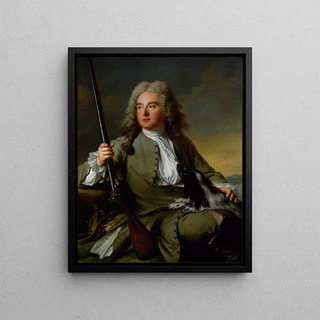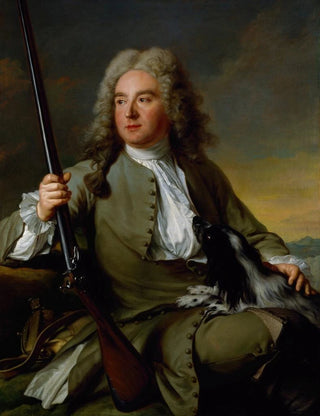Art print | Portrait of a gentleman in hunting attire - Jean-Marc Nattier


View from behind

Frame (optional)
Portrait of a Gentleman Hunter - Jean-Marc Nattier – Captivating Introduction
The "Portrait of a Gentleman Hunter" by Jean-Marc Nattier is a work that embodies the elegance and refinement of the 18th century. This painting, created by a master of portraiture, evokes not only the personality of the subject but also the era in which it was created. Nattier, known for his portraits of high society, manages to capture the very essence of nobility through meticulous details and a delicate color palette. The depiction of a man in hunting attire, with his determined expression and penetrating gaze, invites the viewer to immerse themselves in a world where art and nature meet, thus revealing a fascinating story behind each brushstroke.
Style and uniqueness of the work
Nattier's style is distinguished by its luminous approach and its ability to render textures with remarkable precision. In this portrait, every element, from the rich fabric of the gentleman's outfit to the subtle nuances of shadows, is treated with special care. The background, often blurred in Nattier's works, highlights the main subject while adding depth to the composition. The artist succeeds in creating an atmosphere that is both intimate and majestic, where the hunter seems almost to come to life. Details such as accessories and natural elements demonstrate an attention to the smallest aspects, thus reinforcing the uniqueness of this work. The choice of theme, linking man to nature, also underscores an artistic trend of the time, where nobility was often depicted in contexts reflecting their way of life.
The artist and his influence
Jean-Marc Nattier, born in 1685, is one of the most influential portraitists of his time. Trained in his father's workshop, who was also a painter, Nattier established himself thanks to his talent and artistic sensitivity. He had the opportunity to work for the French court, which allowed him to mingle with the most prominent figures of his era. His style, blending classicism and baroque touches, inspired many contemporary artists and left a lasting mark in the world of

Matte finish

View from behind

Frame (optional)
Portrait of a Gentleman Hunter - Jean-Marc Nattier – Captivating Introduction
The "Portrait of a Gentleman Hunter" by Jean-Marc Nattier is a work that embodies the elegance and refinement of the 18th century. This painting, created by a master of portraiture, evokes not only the personality of the subject but also the era in which it was created. Nattier, known for his portraits of high society, manages to capture the very essence of nobility through meticulous details and a delicate color palette. The depiction of a man in hunting attire, with his determined expression and penetrating gaze, invites the viewer to immerse themselves in a world where art and nature meet, thus revealing a fascinating story behind each brushstroke.
Style and uniqueness of the work
Nattier's style is distinguished by its luminous approach and its ability to render textures with remarkable precision. In this portrait, every element, from the rich fabric of the gentleman's outfit to the subtle nuances of shadows, is treated with special care. The background, often blurred in Nattier's works, highlights the main subject while adding depth to the composition. The artist succeeds in creating an atmosphere that is both intimate and majestic, where the hunter seems almost to come to life. Details such as accessories and natural elements demonstrate an attention to the smallest aspects, thus reinforcing the uniqueness of this work. The choice of theme, linking man to nature, also underscores an artistic trend of the time, where nobility was often depicted in contexts reflecting their way of life.
The artist and his influence
Jean-Marc Nattier, born in 1685, is one of the most influential portraitists of his time. Trained in his father's workshop, who was also a painter, Nattier established himself thanks to his talent and artistic sensitivity. He had the opportunity to work for the French court, which allowed him to mingle with the most prominent figures of his era. His style, blending classicism and baroque touches, inspired many contemporary artists and left a lasting mark in the world of






